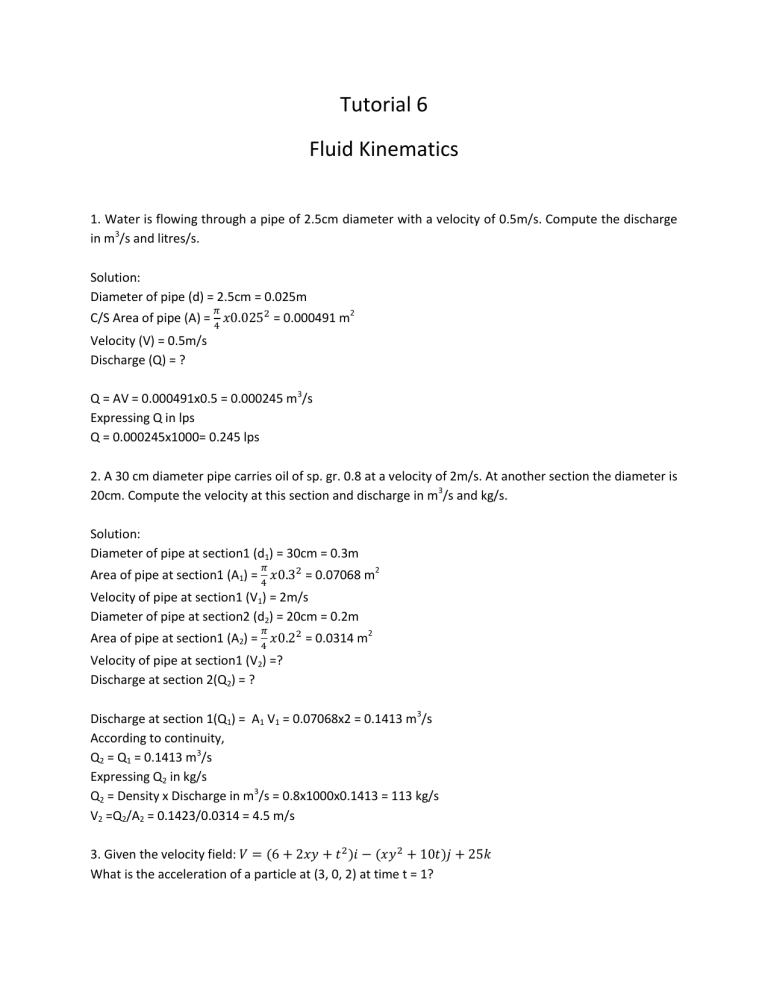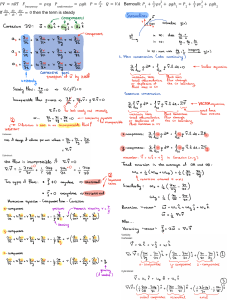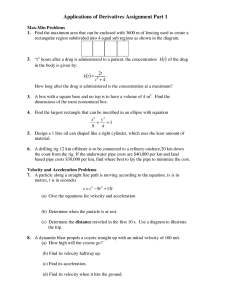
Tutorial 6 Fluid Kinematics 1. Water is flowing through a pipe of 2.5cm diameter with a velocity of 0.5m/s. Compute the discharge in m3/s and litres/s. Solution: Diameter of pipe (d) = 2.5cm = 0.025m C/S Area of pipe (A) = = 0.000491 m2 Velocity (V) = 0.5m/s Discharge (Q) = ? Q = AV = 0.000491x0.5 = 0.000245 m3/s Expressing Q in lps Q = 0.000245x1000= 0.245 lps 2. A 30 cm diameter pipe carries oil of sp. gr. 0.8 at a velocity of 2m/s. At another section the diameter is 20cm. Compute the velocity at this section and discharge in m3/s and kg/s. Solution: Diameter of pipe at section1 (d1) = 30cm = 0.3m Area of pipe at section1 (A1) = = 0.07068 m2 Velocity of pipe at section1 (V1) = 2m/s Diameter of pipe at section2 (d2) = 20cm = 0.2m Area of pipe at section1 (A2) = = 0.0314 m2 Velocity of pipe at section1 (V2) =? Discharge at section 2(Q2) = ? Discharge at section 1(Q1) = A1 V1 = 0.07068x2 = 0.1413 m3/s According to continuity, Q2 = Q1 = 0.1413 m3/s Expressing Q2 in kg/s Q2 = Density x Discharge in m3/s = 0.8x1000x0.1413 = 113 kg/s V2 =Q2/A2 = 0.1423/0.0314 = 4.5 m/s ( ) ( ) 3. Given the velocity field: What is the acceleration of a particle at (3, 0, 2) at time t = 1? Solution: ( ) ( ) At (3,0,2) and t = 1 ( ) ( ) ) ( ) At (3,0,2) and t = 1 ( ( ) ( = 62 ) ) ( ) At (3,0,2) and t = 1 ( Acceleration ( ) ( ( ( ) = 10 ) ) ( ) =0 =√ √ = 62.8 4. A conical pipe diverges uniformly from 0.1m to 0.2m diameter over a length of 1m. Determine the local and convective accelerations at the mid section assuming (a) rate of flow is 0.1 m 3/s and it remains constant, (b) at 2 sec if the rate of flow varies uniformly from 0.1 to 0.2 m3/s in 5Sec. Solution: 1m Dx 0.1m 0.2m x At any distance x, diameter is ( ) ( Cross sectional area ( ) Velocity of flow ( ) ) [ ( ( )] ( ) ( ) 3 (a) Q = 0.1 m /s (constant) Local acceleration = = 0 (steady) Convective acceleration = ( ) ) At mid section (x = 0.5m), Convective acceleration ( ) = 42.74 m/s2 (b) Q varies uniformly from 0.1 to 0.2 m3/s in 5Sec At t = 2S ( Q= ) = 0.14 m3/s Local acceleration = ( ) At x = 0.5m, t = 2s Local acceleration = ( = 1.132 m/s2 ) Convective acceleration = ( ) ( ) At x = 0.5m Convective acceleration ( ) = 83.77 m/s2 5. The following cases represent the two velocity components, determine the third component of velocity such that they satisfy the continuity equation: a) u = 3x2, v = 4xyz w=? According to continuity equation, ( ) ( ∫ ( ) ) ( ) b) u = 5x2+2xy, w = 2z3-4xy-2yz v=? According to continuity equation, ( ) ∫ ( ( ) ) ( ) 6. Which of the following velocity fields satisfies continuity equation? a) u = 4xy+y2, v = 6xy+3x Solution: To satisfy the continuity equation, Computing ( ) ( ) = 4y +0+6x+0 = 4y+6x Here, Therefore, it does not satisfy continuity. b) u =2x2+y2, v = -4xy Solution: To satisfy the continuity equation, Computing ( ) ( ) = 4x +0-4x = 0 Here, Therefore, it does satisfy continuity. c. u = 2x2-xy+z2, v = x2-4xy+y2, w = -2xy-yz+y2 To satisfy continuity equation, Computing ( ) ( = 4x-y+0+0-4x+2y-0-y+0 = 0 Therefore, it does satisfy continuity. d. , ) ( ) Solution: To satisfy the continuity equation, Computing ( ( )( ( ) ) ) ( ) ( ) ( )( ) =0 Here, Therefore, it does satisfy continuity. 7. A 40cm diameter pipe, conveying water, branches into two pipes of diameters 30cm and 20cm respectively. If the discharge in the 40cm diameter pipe is 0.38m3/s, compute the average velocity in this pipe. If the average velocity in 30cm diameter pipe is 2m/s, find the discharge and average velocity in 20cm diameter pipe. 2 1 3 Solution: Diameter of pipe 1 (d1) = 40cm = 0.4m C/S Area of pipe 1 (A1) = = 0.1256 m2 Diameter of pipe 2 (d2) = 30cm = 0.3m C/S Area of pipe 2 (A2) = = 0.07068 m2 Diameter of pipe 3 (d3) = 20cm = 0.2m C/S Area of pipe 3 (A3) = = 0.0314 m2 Discharge through pipe 1(Q1) = 0.38 m3/s Velocity at pipe 2 (V2) = 2m/s Velocity at pipe 1 (V1) = ? Discharge through pipe 3(Q3) = ? Velocity at pipe 3 (V3) = ? V1 = Q1/A1 = 0.38/0.1256 = 3.025m/s Q2 = A2 V2 = 0.07068x2 = 0.1413 m3/s From continuity, Q1 = Q2 + Q 3 Q3 = Q1- Q2 = 0.38 – 0.1413 = 0.2387 m3/s V3 = Q3/A3 = 0.1387/0.0314 = 7.6m/s 8. Is the continuity equation for steady, incompressible flow satisfied with the following velocity components in polar co-ordinate? ( ), a. , Solution: To satisfy the continuity equation, ( ) ( ( Computing ( ) ) ( ) ( ) ) ( ) ( ) ( ( )) =0 ( Here, ) ( ) Therefore, the continuity equation is satisfied. ( b. ), ( ) Solution: To satisfy the continuity equation, ( ) ( ( Computing ( ) ) ( ) ( ) ( [ ) ( * ( ( ( ) ) * Here, ) ) ( ( ( ) ( + ( )) * ( ] * )+ * ( ) Therefore, the continuity equation is satisfied. )) ( ( )+ )+ )+ ( 9. In polar co-ordinate, the two velocity components are given as Determine ( ) from the incompressible relation if umax is constant.. ) and . Solution: From continuity equation, ( ) ( ( ) ( ) ( ) ∫ ( ) ( ( ) [ ( )] ) ) 10. The water tank in the following figure is being filled through section 1 at v1 = 5m/s and through section 3 at Q3 = 0.012 m3/s. If water level h is constant, determine the exit velocity v2. 3 Q3 = 0.012m3/s 1 D1 = 40mm h 2 D2 = 60mm Solution: Diameter of pipe 1 (d1) = 40mm = 0.04m C/S Area of pipe 1 (A1) = = 0.001257 m2 Diameter of pipe 2 (d2) = 60mm = 0.06m Area of pipe at section2 (A2) = = 0.002827 m2 Velocity of pipe at section1 (V1) = 5m/s Q3 = 0.012 m3/s Exit velocity (v2) = ? Discharge through pipe1 (Q1) = A1 V1 =0.001257x5 = 0.006285 m3/s Discharge through pipe 2 (Q2) = Q1 + Q3 = 0.006285+0.012 = 0.018285 m3/s V2 = Q2/A2 = 0.018285/0.002827 = 6.5m/s 11. Water flows from A to D and E through series pipelines shown in the figure. D d3, Q3,V3 A B d1, Q1, V1 d2,Q2, V2 C E d4, Q4, V4 Diameter of pipe AB = 50mm, Diameter of pipe BC = 75mm, Diameter of pipe CE = 30mm, velocity in pipe BC = 2m/s, velocity in pipe CD = 1.5m/s, Q3 =2Q4 Compute Q1, V1, Q2, d3 and V4. Solution: Diameter of pipe AB (d1) = 50mm = 0.05m C/S Area of pipe AB (A1) = = 0.001963 m2 Diameter of pipe BC (d2) = 75mm = 0.075m C/S Area of pipe BC (A2) = = 0.004418 m2 Diameter of pipe CE (d4) = 30mm = 0.03m C/S Area of pipe CE (A4) = = 0.000707 m2 Velocity in pipe BC (V2) = 2m/s Velocity in pipe CD (V3)= 1.5m/s Q3 =2Q4 Q1, V1, Q2, d3 and V4 = ? Q2 = A2 V2 = 0.004418x2 = 0.008836 m3/s Q1 = Q2 = 0.008836 m3/s V1 = Q1/A1 =0.008836/ 0.001963 = 4.5m/s Q2 = Q3+Q4 =2Q4+ Q4 = 3 Q4 Q4 = Q2/3 = 0.008836/3 = 0.002945 m3/s V4 = Q4/A4 =0.002945/0.000707=4.17m/s Q3 =2Q4 = 2x0.002945 = 0.005891 m3/s A3 = Q3/V3 = 0.005891/1.5 = 0.003927m2 d3 = 0.07m = 70mm 12. The velocity potential ( ) is given by . Find the velocity components in x and y direction. Also show that represents a possible case of fluid flow. Solution: u = ?, v= ? The given value of represents a possible case of fluid flow if it satisfies Laplace equation. , , Substituting above values in Laplace equation, we get Hence, the given value of represents a possible case of fluid flow. 13. A stream function ( ) is given by and direction of resultant velocity. . Calculate the velocity components, and magnitude Solution: u = ?, v= ? Resultant velocity ( ) √ Direction of resultant velocity ( ) √ = 5.38 = 21.80 14. If, for a two dimensional potential flow, the velocity potential is given by ( determine the velocity at point (2, 3). Determine also the value of stream function at point (2, 3). Solution: ( ) ), Velocity at point (2, 3) = ? ? = -20 =-24 Resultant velocity ( ) √ √( ) ( ) = 31.2 (a) (b) Integrating a with respect to x (c) c is a constant which is independent of x, but may be a function of y. Differentiating c with respect to y (d) From b and d Integrating Substituting in c = -18 15. The stream function for a two dimensional flow is given by function. Solution: (a) (b) Integrating a with respect to x (c) c is a constant which is independent of x, but may be a function of y. Differentiating c with respect to y (d) From b and d Integrating . Find the velocity potential Substituting in c 16. For the velocity potential function given as: u = ay sinxy, v = ax sinxy, obtain an expression for velocity potential function. Solution: u = ay sinxy, v = ax sinxy (a) (b) Integrating a with respect to x (c) c is a constant which is independent of x, but may be a function of y. Differentiating c with respect to y (d) From b and d c =0 Substituting in c 17. The velocity components in a two-dimensional flow are: , that these velocity components represent a possible case of an irrotational flow. Solution: , , Continuity equation As the continuity equation is satisfied, it is a possible case of fluid flow. The rotation is given by ( As ) ( , the flow is irrotational. ) . Show 18. Show that the following stream function represents an irrotational flow. Solution: The rotation is given by ( As ) ( ) , the flow is irrotational. 19. Given the velocity vector V = ax i + by I, where a, b = constant. Plot the streamlines of flow and explain whether stagnation point occurs. Solution: u = ax, v = by From continuity, a+b = 0 a = -b With this, u = ax, v = -ay Equation of streamline Integrating ∫ ∫ xy = c This is the general expression for streamlines, which are hyperbolas. Plotting Let c= 0, xy = 0 x = 0, y can have any value y = 0, x can have any value Let c = 1 xy = 1 y = 1/x For +ve x, y is also +ve For –ve x, y is also –ve. Hence there are 2 streamlines corresponding to c = 1 in first and third quadrant (for C>0). Y O X For C<0, there are 2 streamlines in second and fourth quadrant. For u = 0 and v = 0 (at stagnation point) ax= 0 i.e. x=0 -ay = 0 i.e. y=0 At origin (0,0), the velocity is zero, which is stagnation point. At this point two streamlines have opposite directions and intersect each other. Direction of streamlines Looking at velocity, u = ax, v = -ay First quadrant: down Second quadrant: down Third quadrant: up Fourth quadrant: up 20. If u = ax, v = ay and w = -2az are the velocity components for a fluid flow, check whether they satisfy the continuity equation. If they do, is the flow rotational or irrotational? Also obtain equation of streamlines passing through the point (2, 2, 4). Solution: u = ax, v = ay and w = -2az = a+a-2a = 0 The continuity equation is satisfied. Rotational components ( ) ( ) ( ) ( ) ( ) ( ) As the rotational components are zero, the flow is irrotational. Equation of streamline Considering first and second equations Integrating (a) Considering first and third equations Integrating (b) At (2,2,4) C1 =2/2= 1, C2 =2x41/2 = 4 Hence the equation of streamline and





